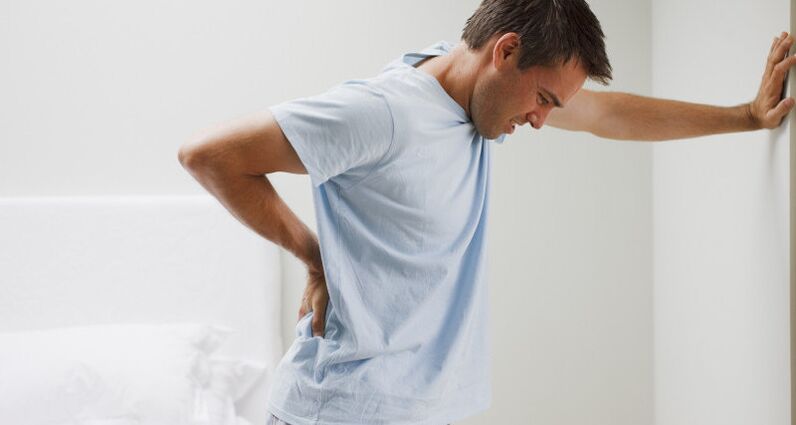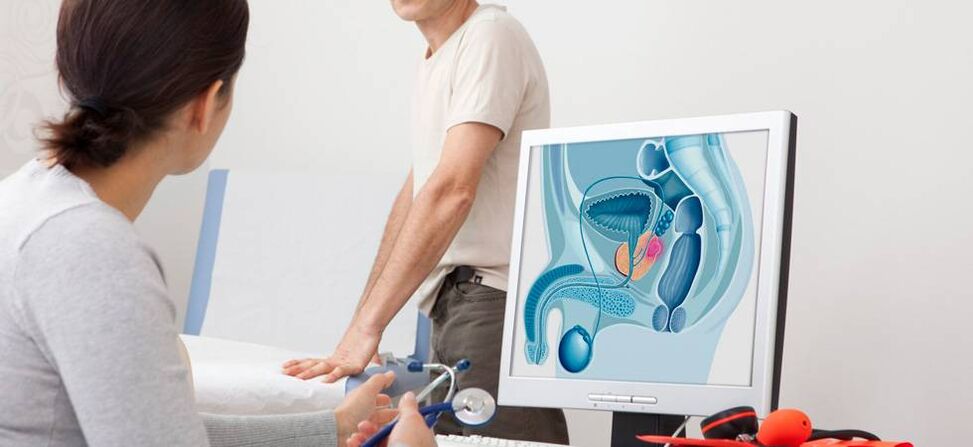The pathology of the prostate gland, which develops due to inflammatory processes in it, is called disease - prostatitis.
The development of pathology
More often than others, there is an infectious form of prostatitis. The infection capable of impressing the prostate penetrating the urethral hole or other organs and glands of the genitourinary system.
The high probability of organ infection is due to the adjacent location of the anus and the urethral channel.
With this probability, statistics detect an inflammatory inflammation of the prostate in men, which is associated with the body's ability to infected neighbors.
Even the presence of prostate infection does not guarantee the development of inflammation.
The inflammation of the prostate occurs with the joint action of the pathogenic microorganisms and the provocative factors.
The causes of prostatitis
Each man, taken by surprise or understanding the inevitability of the disease due to the exacerbation of provocative factors, can guess the course of prostatitis.

The prostate gland is a place for the transit of the urethral channel, therefore, the inflammatory process in a sick organ, which leads to an increase in its structures, leads to a violation of the emptying of the bladder.
By establishing a diagnosis for different forms of inflammation of the prostate gland, binary nomenclature is used:
- Non -infectious chronic
- Chronic infectious
- Infectious acute
- Acute non -infectious
Prostatitis varieties are due to a complex of provocative factors under certain circumstances.
The first factor that prevails statistically in young men and previous age, infections transmitted by the sexual couple.
Venus diseases, especially in the stage of symptomatic remission, can leave behind an infection in a hidden state or prostate injuries, which progressive even after the elimination of an infectious agent.
The infection can complement the infection, the systematic excess, the nutrition of acute foods, excessively oily and caloric carbohydrates.
This is how non -infectious prostatitis occurs and the course of a non -infectious variety is improved.
The provocative factors are the changes related to hypothermia and age in the prostate.
Men's prostatitis signs
It is difficult to diagnose an infectious or non -infectious form of inflammation of the prostate, based only on the similarity of symptoms.
If the following prostatitis signs are detected, it is necessary to make an integral diagnosis of methods to detect the disease:
- During the emptying of the bladder, pain and intensity are experienced, after the end of urination, the patient feels an ardor feeling in the urethra;
- body temperature exceeding normal;
- The sensation of incomplete emptying of the bladder after the end of urination does not leave the sick man for some time;
- The pain in the period between urine is felt in the perineum, the inguinal and abdominal areas, reflected in the legs, the buttocks, the pelvis and the sacrum;
- Lethargy and discomfort.
A man can form suspicion of prostatitis if at least two of them become notable throughout the list and symptoms.
A specific sign of the inflammatory process in the prostate is the measured temperature difference in different parts of the body.
The temperature changes pattern is associated with the location of the inflammation approach: the closer to it, the greater the temperature.
When measuring the temperature in the oral cavity, no deviations from the norm, in the armpits, a subfebrile temperature, in the rectum the value of the parameter exceeds the standard greater than in a degree.
The pain symptom develops with an increase in intensity as inflammation increases in the prostate.
The typical pain of pain is characteristic of the process of emptying the bladder, during the day the pain extends to the rectum and the entire area of the perineum.
The intensity of pain increases with a small to unbearable.
Pure and discomfort can be accompanied by dizziness and headaches, small attacks of nausea, drowsiness.
If such symptoms are detected, urine delay is suspected, as a result of which the general body intoxication develops protein decomposition products.

Urine deviations are associated with the slow stream, a long release of dripping urine, not the imminent formation of a jet and calls to empty the bladder in the absence of urine release.
Possible complications
Complications after prostatitis occur in the absence of medical intervention in the course of the disease or inadequate compilation of a treatment regime.
Medical practice shows the most frequent distribution after prostatitis:
- lack of erection and ejaculation;
- the spread of the inflammatory process to the nearby organs of the genitourinary system;
- cytological disorders that lead to sperm inability to fertilize eggs;
- decrease in libido;
- Psychoneurotics states that reduce the quality of life and health status of a man as a whole.
After prostatitis, the penis sharply reduces the ability to harden and fill with blood. Possible sexual contacts end up quickly compared to recent recent sexual life. Not all sexual contact ends with ejaculation.
If such deviations are detected, comprehensive diagnostic test is required.
With the spread of the inflammatory process to the urethra and the bladder, cystitis and urethritis are developed.
With the development of the latter, the pain of acute nature appears, the process of exit of deteriorated urine (its delay or incontinence) threatens to change to a chronic level. The performance of a man in this state is doubtful.
Erectile dysfunction leaves a series of psychological and therapeutic problems that need competent medical correction.
The impossibility of cavernous bodies being filled with blood is explained by the edematous state of the prostate and associated genitourinary organs.
The blood supply to the penis, necessary for an erect state, becomes problematic.
Psychologically, the third part of the men that has been developed by consequences after prostatitis suffers severely.
The status of a man can normalize only during long -term psychological work with the patient in the context of pharmacological therapy. Failures in sex life prevent the greatest desire to continue sexual life.
Prostatitis can cause a violation of the acid-base composition of sperm, reflected in the sperm fertilization capacity.
The result of pathology is infertility in a first -degree man. It is important in this state to timely eliminate the cause of infertility due to the lack of the opportunity to cure second degree infertility with a drug method. The Andrologist or Urologist can prescribe proper treatment. That is why men should not ignore prostatitis signs.
Diagnosis
The diagnostic exam scheme depends directly on those complaints and signs with which the patient addresses the urologist or andrologist.
The diagnosis of prostatitis in men can be performed both at home and in a medical institution.
The initial diagnostic stage is data collection for anamnesis. The doctor performs an external inspection of the genitals and listens to the patient's complaints.
According to the initial data, a scheme of an additional diagnostic study of a sick man is established.
During the collection of an anamnesis, the doctor discovers the duration of the symptoms that appeared, the presence of prostatitis previously shown, a list of diseases by the patient, risk factors for the development of the disease, a possible list of transmitted sexually transmitted diseases, the development of disease signs, the presence of sexual partners and sexual intercourse.
In the current stage of the development of medicine, the list of questions is published in the questionnaire, which the patient fills before visiting the doctor's office. Therefore, the patient's time and the doctor are saved.
The first mandatory stage of the patient exam with signs in prostatitis is the study of the prostate gland of the rectum.
The doctor determines the degree of increase in the inflamed organ, its density, the uniformity of the consistency or the presence of nodes or stamps, the degree of pain during palpation.
Before palpation, intestinal cavity is performed.
In the absence of an inflammatory process in the prostate, there is no pain, with prostatitis, the intensity of pain can be different, and its location is felt in the groin, the rectum, the perineum and the sacrum. In this case, it is contraindicated in a series of procedures, for example, cystography.
For a microscopic examination of the secretion of the prostate gland, the patient is performed by massage of the prostate through the rectum.
With the desire to urinate until the end of the prostate massage, this cannot be done until a fall in the secretion of the prostate of the urethral opening for the analysis is taken.
The procedure ends in the realization of the urese glass along the urethra hole, after which the smear is painted and the microscopic analysis according to the following parameters:
- the presence of leukocytes and the calculation of their quantity;
- amount of lecithin;
- The activity of pathogenic microorganisms and their presence.

The detection of bacteria in the field of vision of the smear indicates the infectious type of prostatitis.
The number of leukocytes in the field of vision of more than 2 indicates the inflammatory process in the prostate.
For a reliable result of a microscopic examination, it is necessary to correctly take a fence for the analysis and paint the medication competently.
The above tests are mandatory, the doctor selectively recipes the additional exams, depending on the suspicions of the doctor about the nature of inflammation.
The analysis of the urethra's secret is carried out by a tool similar to a catheter. In the upper part of the metal coating, the cotton is injured.
Before passing the analysis, urine is excluded for 2-3 hours. Otherwise, microflora is washed in the external environment.
The doctor introduces a cotton swab of approximately 4 cm into the penis hole and performs rotation movements. A smear of the urethra is investigated due to the presence of DNA and bacteria residues.
Urine analysis is a means to detect blood cells: red blood cells and leukocytes, proteins (normally absent or present in traces quantities).
By making mistakes in the analysis of the smear symptoms of urethra and prostatitis, urine planting is prescribed for bacteriological analysis.
The disadvantage of the method is the long -term expectation of a colony of pathogenic microorganisms (up to 1 week).
The planting is carried out by means of a comparative method after the nearly three portions of urine (beginning, medium and end of the emptying of the bladder).
A greater number of pathogenic microorganisms in one of the samples gives the basis of the assumption of the infection location approach.
The detection in the first part of the urine of bacteria does not give a reason to confirm inflammation.
The second and third part of the urine, in excess of the number of microorganisms detected, give the basis to clarify the location of inflammation (in the urethra and the bladder, respectively).
The degree of deviation of the sexual function of the norm is verified by the analysis of the sperm for viscosity and other physicochemical indicators of the environment, the activity and viability of the male gametes, and a sperm is rarely prescribed.
The uroofloometric method is often organized. If the possibility and addition of the image of the changes take place, an urinary tract exam is carried out.
An ultrasound exam specifies the density of the sick organ and other parameters obtained after an examination of the prostate fingers through the rectum.
The prostate gland is visible in two ways: transrectal ultrasound and ultrasound through the abdominal cavity.
In case of suspicion of adenoma and prostate cancer, the doctor can prescribe an additional cytoscopic examination of the blood, the dog test called that.
The fence is made of a vein, establishes a blood test (excludes) the presence of RSA protein, which appears with malignant tumors.
At home, the patient can suspect prostatitis, focusing on the color and turbidity of urine, the symptoms of the disease.
How to treat at home
Supply of pharmaceutical products
If signs of prostatitis appear, men should not self -medicate, medicines should only be prescribed by a doctor.
The preparations proposed for healing prostatitis are distinguished by a variety of pharmaceutical forms and properties. Most of the time they are prescribed candles for rectal use.
The justification for the choice of doctors is associated with the proximity of the effects of the components of the rectal suppositories and the prostate gland.
The condition for the effective effect of the active substance of the candles in the organ of the organ is the patient's peace in a liar position for 30 minutes after the administration of the rectal drug. Candles inactivate pathogenic microflora and have an analgesic effect.
Intramuscular and intravenous injections contribute to the fastest effect on the sick organ through propagation through the bloodstream.
Immediately after urine, instillations are prescribed to penetrate medicinal substances into the prostate through the urethral hole. The maximum amount of administration is 5 ml.
Table forms for prostatitis are better known as antibiotics divided into 3 groups and successfully handle the possible variety of pathogenic microflora types:
- Tetracyclines
- Fluoroquinolones
- Penicillins
Warm microclines with introduced substances are carried out at night.
The main condition for using enema is the inadmissibility of gland voltage and compliance with the temperature regime. It refers to popular methods to treat prostatitis.

























